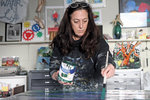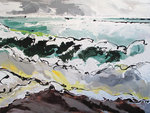In the afternoon, golden rays of sunlight glint off Discovery Bay and fill Meg Kaczyk’s southward-facing Cape George basement studio. But it is in the twilight hours when the painter does most of her work.
“I work in the night a lot,” she said. “There is so much during the day that takes the business side of art, whether it is teaching or doing my own marketing or phone calls.
This item is available in full to subscribers.
We have recently launched a new and improved website. To continue reading, you will need to either log into your subscriber account, or purchase a new subscription.
If you had an active account on our previous website, then you have an account here. Simply reset your password to regain access to your account.
If you did not have an account on our previous website, but are a current print subscriber, click here to set up your website account.
Otherwise, click here to view your options for subscribing.
* Having trouble? Call our circulation department at 360-385-2900, or email our support.
Please log in to continue |
|


In the afternoon, golden rays of sunlight glint off Discovery Bay and fill Meg Kaczyk’s southward-facing Cape George basement studio. But it is in the twilight hours when the painter does most of her work.
“I work in the night a lot,” she said. “There is so much during the day that takes the business side of art, whether it is teaching or doing my own marketing or phone calls.
Kaczyk and her husband moved to Cape George in 2015 from Portland, Oregon, where she had been a creative director at a marketing and advertising firm.
“Portland was getting big and busy, and we had always planned on retiring early, and we wanted a small town that wanted culture and community and beauty, and Port Townsend became it,” she said. “We did have some connections up here, some friends living here.”
And the view was outstanding, something always welcomed by an artist.
“That clinched it for moving to Cape George,” she said.
Kaczyk has been working on three separate painting projects. The themes are “Water Ways,” “Big Fruit” and “Madrona.”
“Still lifes have been a staple of a lot I have done,” she said. “I love their sense of contentment and harmony and abundance, but I just recently have been reinspired.”
The process
“How I work is I do watercolors, and then I paint from the watercolors,” Kaczyk said. “I paint,using them as a reference. I have been inspired to go really big. This paint is acrylic enamel and latex. I have been painting with it for probably 15 years now, and I love the way it behaves. I love that it is durable, that it is opaque. It does some marbling things if you do it wet together. I just love working with it. It is very fluid, very liquid.”
The larger painting is not intended as a replica of the original work.
“My point is not to make a faithful representation,” Kaczyk said. “First of all, you can’t. The size is different and the medium is different, so you can’t make a faithful representation. It is not like I expect them to look exactly alike. Compositionally, it will be similar, where things are. My thing is taking that as a leaping-off point. What does the next size and medium add to it?”
Kaczyk said she leads the brush, not the other way around.
“I do, absolutely. Even when I am dripping — I do a lot of dripping — there are happy accidents that I know I will either keep or paint over because I can with this paint. It is opaque. I like the happy accidents — part of that is the freedom of it. That is still me deciding whether it stays or goes. Ultimately, I am the boss.”
A hidden message?
“Right now, I am working on three things, so, thematically, there is sort of a message,” Kaczyk said. “The ‘Big Fruit’ to me says agriculture and land and abundance. Food as life. It is really honoring that and really thinking about, like around here, the importance of agriculture.”
For her second series, “Water Ways,” Kaczyk conveys what she sees in the waters surrounding three sides of Port Townsend.
“My vision for that is to show all these different views of the water,” she said. “Again, the message there is my inspiration and desire in painting to capture the preciousness of this precious resource, the Salish Sea, that is all around us.”
By painting her surroundings, Kaczyk finds she is able to better understand them.
“Really, it is a part of learning it,” she said. “As an artist, visually water is so fascinating. It is always different. It is always changing with the land and sky. It is just lovely. Just walking on any of the beaches around here or being on the ferry is amazing. Just the shades of color are lovely, and it is a wonderful challenge to try and capture it.”
Kaczyk’s third series, “Madrona,” focuses on the particular species of tree that is prevalent in the area.
“I have been working for the last year on the Madrona series,” she said. “I just love the trees. I think they are amazing. They are unique to this area. It is really a sense of place around them and they are also under duress a little bit, so there is a sense of preciousness about them.”
One of the trees she depicted, located at Fort Worden and named “Grandmother,” currently is in excellent health.
“Grandmother is amazing and crazy healthy,” Kaczyk said.
All three series are intended to connect viewers with the natural beauty of the North Olympic Peninsula and Salish Sea.
“My hope is that I can connect this love of land and food and water with a lot of the area nonprofits around here,” Kaczyk said. “I am moving, and I would like to somehow connect the work they do with the work I do. A certain portion of the proceeds go to those nonprofits.”
Healing art
Kaczyk’s works are on display at Jefferson Healthcare as part of the Northwind Arts Center’s “Art in the Hospital” program.
“I love the healing power of art,” Kaczyk said. “My husband has a rare form of cancer that requires constant treatment. We are in the hospitals a lot. He is OK, but it is maintenance.”
Art in such environs has a great power to heal, Kaczyk said.
“I know from our own experience, we’ve spent a lot of time in hospitals at the Seattle Cancer Care Alliance. They have beautiful art there, and I just think art has the capacity to just bring so much joy and healing and peace. That makes me really excited when I see people happy with my art.”
As cancer is ever-present in Kaczyk’s life, painting provides curative properties.
“I think it is helpful to have something that just brings a lot of joy both to me and to others, and it is also something that is really mine as a caregiver,” she said. “It is nice to have something that is an expression of myself, and he loves my art. He is really supportive of it.”
When is it done?
Knowing when to stop adding to the canvas is key for Kaczyk’s paintings.
“I will say though that some paintings, they are done wherever they ended,” she said. “There is nothing more I can add to it. It is what it is.”
But knowing when to stop may not be immediately apparent.
“Sometimes if you are not sure, you live with it for a while,” Kaczyk said. “One reason is I like to paint flat and sometimes you need to let it dry, especially when you think you are getting near the end.”
When painting, Kaczyk places her canvases flat atop either a sawhorse or on top of empty 5-gallon paint buckets nearby.
“I have two going at once, one up on the sawhorse and one atop these buckets down below,” she said.
That allows Kaczyk to move back and forth between paintings.
“With this technique as well, I can’t do it all at once,” she said. “It has to dry in between the layers. That gives you time to think and to look at it while it is drying, and it has dry at least 24 hours before I can paint again because it is really wet.”
Kaczyk enjoys creating each piece, but she also enjoys when others view her art.
“I would say if I didn’t enjoy creating it, I wouldn’t even be doing it, so I would say that is first, the creation,” she said. “It just gets me really excited because it is my way of seeing the world. It is how the world comes through me. I am not a photographic painter, it is more of the expressionist style, so, to me, that is where the alchemy takes place, when I take in the world and how that transforms through my brush.”